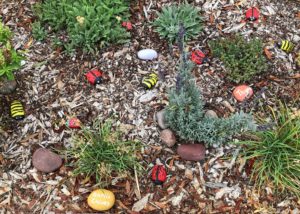Art
The garden can be the site for art lessons and it can provide inspiration for art lessons in the classroom. Ideas and rough sketches from the garden can lead to wonderful artistic expression. The class can create a bulletin board, PowerPoint, or book (e.g., Our Garden Up Close). Have clipboards available for students to use for garden illustrations. The students can:
-
- Try field sketching with notes of plants and animals found in the garden.
- Use different media to capture the beauty of the garden, both close-up and as a landscape. Have students conduct close-up observations and record them with a camera or sketch.
- Have students try to find where another student’s photo was taken or sketch was made.
Crafts
Ideas abound for garden related crafts. Use an internet search for seasonal garden ideas. Workshops, craft and garden shops, magazines, and other teachers are also good sources for craft ideas. Students can use dried flowers or gourds in craft projects and sell them or give them as gifts. One idea is to grow pumpkins with their names etched in as they grow. Ice-cream sticks, tongue depressors, paint sticks, or smooth rocks make decorative plant or row markers. Create art for the garden. They might build birdhouses and feeders, or owl or bat boxes.

Music
Many popular songs have been written about the garden (e.g., Inch Worm, Inch Worm, Measuring the Marigolds, Garden Song – “Inch by Inch, Row by Row, Gonna Make This Garden Grow”). Garden themed lyrics have been adapted to many familiar tunes. Search for “garden song” or in The Growing Classroom or Life Lab Music from Sowing the Seeds of Wonder Music CD. If you have a sound system, introduce different kinds of music while children are working in the garden. Even classical music can be enjoyed while gardening. “The Flight of the Bumblebee” becomes a real experience and can lead to a science lesson on bees. In nice weather, the garden can also provide a location for instrumental music instruction.
Plays
Students can collaborate to write plays in the garden. If there is an outdoor area for a “stage” and space for an audience, the garden can be the setting for the performance. If the garden area has room for more than one class, classes can perform for each other.
Array